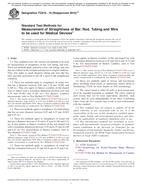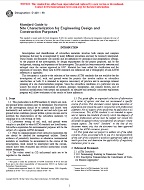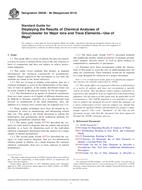1.1 This test method covers an engine test procedure for the measurement of the effects of automotive engine oils on the fuel economy of passenger cars and light-duty 3856 kg (8500 lb) or less gross vehicle weight trucks. The tests are conducted using a specified 4.6-L spark-ignition engine on a dynamometer test stand. It applies to multiviscosity grade oils used in these applications.
1.2 This test method also provides for the running of an abbreviated length test that is referred to as the VIBSJ. The procedure for VIBSJ is identical to the Sequence VIB with the exception of the items specifically listed in Annex A13. The procedure modifications listed in Annex A13 refer to the corresponding section of the Sequence VIB test method.
1.3 The unit values stated in this test method shall be regarded as the standard. Values given in parentheses are provided for information purposes only. SI units are considered the primary units for this test method. The only exception is where there is no direct SI equivalent such as screw threads, national pipe threads/diameters, tubing size, and so forth.
1.4 This standard does not purport to address all of the safety concerns, if any, associated with its use. It is the responsibility of the user of this standard to establish appropriate safety and health practices and determine the applicability of regulatory limitations prior to use.
1.5 This test method is arranged as follows:
| Subject | Section |
|---|---|
| Introduction | |
| Scope | 1 |
| Referenced Documents | 2 |
| Terminology | 3 |
| Summary of Test Method | 4 |
| Significance and Use | 5 |
| Apparatus | 6 |
| General | 6.1 |
| Test Engine Configuration | 6.2 |
| Laboratory Ambient Conditions | 6.3 |
| Engine Speed and Load Control | 6.4 |
| Dynamometer | 6.4.1 |
| Dynamometer Load | 6.4.2 |
| Engine Cooling System | 6.5 |
| External Oil System | 6.6 |
| Fuel System | 6.7 |
| Fuel Flow Measurement | 6.7.2 |
| Fuel Temperature and Pressure Control to the Fuel Flowmeter |
6.7.3 |
| Fuel Temperature and Pressure Control to Engine Fuel Rail |
6.7.4 |
| Fuel Supply Pumps | 6.7.5 |
| Fuel Filtering | 6.7.6 |
| Engine Intake Air Supply | 6.8 |
| Intake Air Humidity | 6.8.1 |
| Intake Air Filtration | 6.8.2 |
| Intake Air Pressure Relief | 6.8.3 |
| Temperature Measurement | 6.9 |
| Thermocouple Location | 6.9.5 |
| AFR Determination | 6.10 |
| Exhaust and Exhaust Back Pressure Systems | 6.11 |
| Exhaust Manifolds | 6.11.1 |
| Laboratory Exhaust System | 6.11.2 |
| Exhaust Back Pressure | 6.11.3 |
| Pressure Measurement and Pressure Sensor Locations |
6.12 |
| Engine Oil | 6.12.2 |
| Fuel to Fuel Flowmeter | 6.12.3 |
| Fuel to Engine Fuel Rail | 6.12.4 |
| Exhaust Back Pressure | 6.12.5 |
| Intake Air | 6.12.6 |
| Intake Manifold Vacuum/Absolute Pressure | 6.12.7 |
| Coolant Flow Differential Pressure | 6.12.8 |
| Crankcase Pressure | 6.12.9 |
| Engine Hardware and Related Apparatus | 6.13 |
| Test Engine Configuration | 6.13.1 |
| ECM/EEC (Engine Control) Module | 6.13.2 |
| Thermostat/Orifice Plate | 6.13.3 |
| Intake Manifold | 6.13.4 |
| Flywheel | 6.13.5 |
| Wiring Harnesses | 6.13.6 |
| EGR Block-Off Plate | 6.13.7 |
| Oil Pan | 6.13.8 |
| Oil Pump Screen and Pickup Tube | 6.13.9 |
| Idle Speed Control Solenoid (ISC) Block-Off Plate |
6.13.10 |
| Engine Water Pump | 6.13.11 |
| Thermostat Housing | 6.13.12 |
| Oil Filter Adapter | 6.13.13 |
| Fuel Rail | 6.13.14 |
| Miscellaneous Apparatus Related to Engine Operation |
6.14 |
| Timing Light | 6.14.1 |
| Reagents and Materials | 7 |
| Engine Oil | 7.1 |
| Test Fuel | 7.2 |
| Engine Coolant | 7.3 |
| Cleaning Materials | 7.4 |
| Preparation of Apparatus | 8 |
| Test Stand Preparation | 8.2 |
| Engine Preparation | 9 |
| Cleaning of Engine Parts | 9.2 |
| Engine Assembly Procedure | 9.3 |
| General Assembly Instructions | 9.3.1 |
| Bolt Torque Specifications | 9.3.2 |
| Sealing Compounds | 9.3.3 |
| Harmonic Balancer | 9.3.5 |
| Oil Pan | 9.3.6 |
| Intake Manifold | 9.3.7 |
| Camshaft Covers | 9.3.8 |
| Thermostat | 9.3.9 |
| Thermostat Housing | 9.3.10 |
| Coolant Inlet | 9.3.11 |
| Oil Filter Adapter | 9.3.12 |
| Dipstick Tube | 9.3.13 |
| Water Pump | 9.3.14 |
| Sensors, Switches, Valves, and Positioners | 9.3.15 |
| Ignition System | 9.3.16 |
| Fuel Injection System | 9.3.17 |
| Intake Air System | 9.3.18 |
| Engine Management System (Spark and Fuel Control) |
9.3.19 |
| Accessory Drive Units | 9.3.20 |
| Exhaust Manifolds | 9.3.21 |
| Engine Flywheel and Guards | 9.3.22 |
| Lifting of Assembled Engines | 9.3.23 |
| Engine Mounts | 9.3.24 |
| Calibration | 10 |
| Stand/Engine Calibration | 10.1 |
| Procedure | 10.1.1 |
| Reporting of Reference Results | 10.1.2 |
| Analysis of Reference/Calibration Oils | 10.1.3 |
| Instrument Calibration | 10.2 |
| Engine Load Measurement System | 10.2.1 |
| Fuel Flow Measurement System | 10.2.2 |
| Coolant Flow Measurement System | 10.2.3 |
| Thermocouple and Temperature Measurement System |
10.2.4 |
| Humidity Measurement System | 10.2.5 |
| Other Instrumentation | 10.2.6 |
| Test Procedure | 11 |
| Preparation for Initial Start-up of New Engine | 11.1 |
| External Oil System | 11.1.1 |
| Flush Effectiveness Demonstration | 11.1.2 |
| Preparation for Oil Charge | 11.1.3 |
| Oil Charge for Coolant Flush | 11.1.4 |
| Engine Coolant Charge for Coolant Flush | 11.1.5 |
| Initial Engine Start-up | 11.2 |
| Coolant Flush | 11.3 |
| New Engine Break-In | 11.4 |
| Oil Charge for Break-In | 11.4.2 |
| Break-In Operating Conditions | 11.4.3 |
| Routine Test Operation | 11.5 |
| Start-Up and Shutdown Procedures | 11.5.8 |
| Flying Flush Oil Exchange Procedures | 11.5.9 |
| Test Operating Stages | 11.5.10 |
| Stabilization to Stage Conditions | 11.5.11 |
| Stabilized BSFC Measurement Cycle | 11.5.12 |
| Data Logging | 11.5.13 |
| BC Oil Flush Procedure for BC Oil Before Test Oil |
11.5.14 |
| BSFC Measurement of BC Oil Before Test Oil | 11.5.15 |
| Test Oil Flush Procedure | 11.5.16 |
| Test Oil Aging | 11.5.17 |
| BSFC Measurement of Aged (Phase I) Test Oil | 11.5.18 |
| Aging Phase II | 11.5.19 |
| BSFC Measurement of Aged (Phase II) Test Oil | 11.5.21 |
| BC Oil Flush Procedure for BC Oil After Test Oil | 11.5.22 |
| BSFC Measurement for BC Oil After Test Oil | 11.5.23 |
| General Test Data Logging Forms | 11.5.24 |
| Diagnostic Review Procedures | 11.5.25 |
| Determination of Test Results | 12 |
| FEI1 and FEI2 Calculations | 12.1 |
| Final Test Report | 13 |
| Validity Statement | 13.1 |
| Report Format | 13.2 |
| Precision and Bias | 15 |
| Precision | 15.1 |
| Validity | 15.2 |
| Test Stand Calibration Status | 15.2.1 |
| Validity Interpretation of Deviant Operational Conditions |
15.2.2 |
| Bias | 15.3 |
| Keywords | 16 |
| Annexes | |
| Role of ASTM TMC | Annex A1 |
| Detailed Specifications and Drawings of Apparatus | Annex A2 |
| Oil Heater Cerrobase Refill Procedure | Annex A3 |
| Engine Part Number Listing | Annex A4 |
| Flying Flush Checklists | Annex A5 |
| Safety Precautions | Annex A6 |
| Report Format | Annex A7 |
| Statistical Equations for Mean and Standard Deviations |
Annex A8 |
| Oil Sump Full Level Determination Consumption Measurement Calibration Procedure |
Annex A9 |
| Fuel Injector Evaluation | Annex A10 |
| Pre-test Maintenance Checklist | Annex A11 |
| Blow-by Ventilation System Requirements | Annex A12 |
| VIBSJ Abbreviated Length Test Requirements | Annex A13 |
| Appendix | |
| Procurement of Test Materials | Appendix X1 |
Product Details
- Published:
- 01/01/2008
- Number of Pages:
- 60
- File Size:
- 1 file , 1.1 MB
- Redline File Size:
- 2 files , 2 MB


